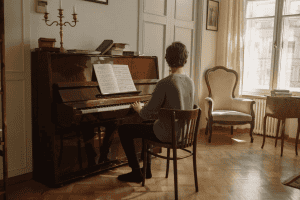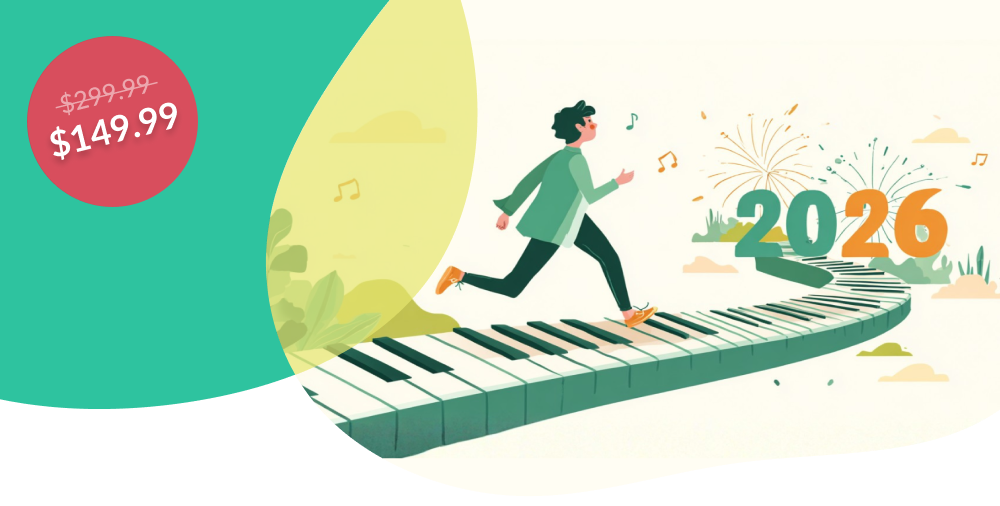Franz Liszt was one of the most important pianists of the 19th century, and his work and style has left an enduring mark on classical music and piano repertoire. His contributions to piano music are vast, with a range of styles and virtuosity that remains continuously inspiring to contemporary pianists.
In this article, we will explore a handful of Liszt piano pieces. Some are suitable for players at the beginning level, while others are reserved for the most advanced students. Along the way, we will explore how resources like Skoove can aid in mastering these masterpieces, offering a comprehensive guide to embarking on or deepening your journey with Liszt’s music.
- Fall in love with the music - Learn your favorite songs, at a level suitable for you.
- Enjoy interactive piano lessons - Explore courses covering music theory, technique chords & more.
- Get real-time feedback - Skoove's feedback tells you what went well and what needs practice.

Overview of Liszt piano pieces
Franz Liszt was a Hungarian composer and pianist who became renowned for his virtuosic skill and innovative compositions. Born in 1811, Liszt’s career spanned a period of significant musical transformation, where he not only adapted to but also shaped the evolving landscape of romantic music.
His works for piano are characterized by their technical demands, emotional depth, and innovative use of the instrument’s capabilities. Liszt’s style often features sweeping arpeggios, intricate finger work, and bold, expressive dynamics. Many of his pieces are counted among the best classical piano songs.
His compositions range from lyrical and introspective to grand and dramatic, reflecting his diverse influences and personal experiences. This versatility has made Liszt’s music a cornerstone of piano repertoire, challenging players to not only hone their technical skills but also delve into expressive interpretation.
The technical challenges in Liszt’s pieces are notable. Many of his works require advanced finger agility, precise control over dynamics, piano hand independence, and an ability to convey complex emotional landscapes.
However, many Liszt piano pieces are more accessible, making his oeuvre an excellent resource for pianists at various stages of their musical journey. Whether you are a beginner eager to explore the world of classical piano or an advanced player seeking to expand your repertoire, Liszt offers something for everyone.
Best Liszt pieces
1. Consolation No. 3 in D-flat major, S. 172
This piece, part of a set of six Consolations, is one of Liszt’s more accessible works, making it a popular choice for beginners. “Consolation No. 3” is characterized by its lyrical and serene melody, reminiscent of a nocturne.
The piece demands a delicate touch and control over dynamics, as its beauty lies in the subtle nuances of phrasing and expression. Despite its relative simplicity, the piece offers a rich emotional experience, encouraging players to focus on tone quality and expressive playing.
2. Liebesträume No. 3 in A-flat major, S. 541
“Liebesträume,” or “Dreams of Love,” is one of Liszt’s most famous compositions. This particular piece, “Liebesträume No. 3,” is a staple of the romantic piano repertoire. It starts with a serene and lyrical melody, evolving into more complex and technically challenging passages.
The piece requires intermediate technical skills, particularly in managing the flowing arpeggios and maintaining a consistent singing tone throughout. The piece’s emotional depth and beautiful melody make it a rewarding intermediate piano song.
3. Hungarian Rhapsody No. 2 in C-sharp minor, S. 244/2
One of Liszt’s most iconic works, the “Hungarian Rhapsody No. 2,” showcases his Hungarian heritage and his flair for dramatic expression. This piece is well-known for its virtuosic demands, making it suitable for advanced pianists.
It features rapid octaves, intricate fingerwork, and dynamic contrasts that require a high level of technical proficiency. The piece is divided into two main sections: a slow, expressive introduction followed by a fast-paced, energetic finale. Its popularity has made it a favorite among concert pianists and audiences alike.
4. Un sospiro (Étude de concert No. 3 in D-flat major, S. 144/3)
“Un sospiro,” meaning “A Sigh,” is part of Liszt’s collection of concert études. This piece is a study in fluid finger movement and control of arpeggios.
While technically challenging, “Un sospiro” is also highly expressive, requiring players to convey a sense of yearning and melancholy. The piece’s cascading arpeggios and lyrical melody provide an excellent opportunity for advanced players to showcase their technical and interpretative skills.
5. Transcendental Étude No. 5 in B-flat major, S. 139/5 (“Feux follets”)
The “Transcendental Études” are among Liszt’s most challenging works, with “Feux follets” being particularly notorious for its difficulty. The title, meaning “Will-o’-the-wisps,” reflects the piece’s elusive and ethereal character.
The étude features rapid, light finger work and requires exceptional agility and precision. This piece is suitable for advanced pianists looking to push the boundaries of their technical abilities while exploring Liszt’s more avant-garde compositional style.
6. La Campanella (Grandes études de Paganini No. 3 in G-sharp minor, S. 141/3)
“La Campanella” is inspired by Niccolò Paganini’s Violin Concerto No. 2 and is part of Liszt’s “Grandes études de Paganini.” The piece is famous for its bell-like melody, which is played in the upper registers of the piano.
It requires advanced technical skills, including rapid repeated notes, wide leaps, and precise articulation. The piece’s light, playful character contrasts with its technical demands, making it a captivating piece for both performers and listeners.
7. Mephisto Waltz No. 1, S. 514
The “Mephisto Waltz No. 1,” also known as “The Dance in the Village Inn,” is one of Liszt’s most dramatic and evocative pieces. It tells the story of a village dance, where Mephistopheles, the devil, plays his violin and enchants the villagers.
The piece is technically demanding, with fast runs, intricate finger work, and dramatic dynamic shifts. It requires not only technical proficiency but also a strong sense of narrative and character portrayal. This piece is ideal for advanced pianists looking to showcase their virtuosity and interpretative skills.
In this video, you can see the progression of Liszt’s works from the age of 10 years old to 73 years.
💡Tips for success
Playing Liszt’s music requires a combination of technical skill, musicality, and emotional expression. Let’s explore some tips you can use to practice the most famous Liszt pieces, or any other easy piano music you are working on.
- Practice slowly: Start by practicing difficult passages at a slow tempo. This allows you to focus on accuracy and develop muscle memory. Gradually increase the tempo as you become more comfortable with the notes.
- Work on finger strength and agility: Many of Liszt’s pieces require strong, agile fingers. Incorporate finger exercises and technical drills into your practice routine to build strength and flexibility.
- Focus on dynamics and phrasing: Liszt’s music is known for its expressive depth. Pay close attention to dynamics and phrasing, and experiment with different interpretations to find the most compelling way to convey the music’s emotional content.
- Use a metronome: A metronome can help you maintain a steady tempo and develop a strong sense of rhythm. Use it to practice challenging sections and ensure that you are playing on time.
- Listen to recordings: Listening to recordings of Liszt’s music can provide valuable insights into interpretation and performance practice. Pay attention to how different pianists approach the music and try to incorporate their ideas into your playing. If you are a beginner or an intermediate piano player, you can get started with some of Franz Liszt’s songs.
Learning Liszt’s pieces with Skoove
Skoove is an excellent resource for piano learners of all levels, offering interactive lessons, sheet music, and real-time feedback. If you are looking to learn Liszt’s music, Skoove provides a structured and supportive learning environment.
One of the key benefits of Skoove is its interactive lessons, which guide you through the learning process step by step. The platform provides sheet music for a wide range of pieces. As you play, Skoove listens to your performance and offers feedback, helping you improve your timing, accuracy, and expression.
Skoove also includes features like video tutorials and practice tips, which can be particularly helpful when tackling challenging pieces like those by Liszt. These resources offer insights into fingerings, technique, and interpretation, making it easier to approach even the most complex music with confidence.
For piano lessons for beginners, Skoove’s lesson plans are designed to build foundational skills, gradually introducing a more challenging repertoire as you progress.
For intermediate and advanced players, Skoove offers a wealth of resources to refine your technique and deepen your understanding of the music. Whether you’re just starting your piano journey or looking to master Liszt’s virtuoso pieces, Skoove provides the tools and support you need to succeed.
The Liszt goes on
Franz Liszt’s piano music is extensive, full of beautiful melodies, intricate passages, and high virtuosity. While his repertoire is generally the pursuit of more advanced pianists, there are simplified versions of his compositions for students of all ability levels.
From the lyrical “Consolation No. 3” to the dramatic “Mephisto Waltz No. 1,” Liszt’s pieces challenge players to develop both technical skills and emotional expression. With dedication, practice, and the right resources, anyone can explore the beauty and complexity of Liszt’s music.
Skoove is an invaluable tool for piano learners, offering interactive lessons and personalized feedback to help you master Liszt’s music. Whether you’re a beginner or an advanced player, Skoove’s comprehensive resources make it easier to learn and enjoy playing the piano.
If you’re inspired to take your piano playing to the next level, consider exploring Skoove’s lessons and discovering the joy of playing Liszt’s music.
Author of this blog post:
Susana Pérez Posada

With over seven years of piano education and a deep passion for music therapy, Susana brings a unique blend of expertise to Skoove. A graduate in Music Therapy from SRH Hochschule Heidelberg and an experienced classical pianist from Universidad EAFIT, she infuses her teaching with a holistic approach that transcends traditional piano lessons. Susana’s writings for Skoove combine her rich musical knowledge with engaging storytelling, enriching the learning experience for pianists of all levels. Away from the piano, she loves exploring new places and immersing herself in a good book, believing these diverse experiences enhance her creative teaching style.
Published by Lydia Ogn from the Skoove team















